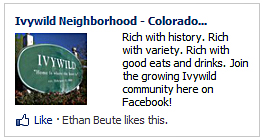“Proudly a macro beer.” Who would say such a thing? Why? And how?
For the answers, here’s a quick look at the 2015 Budweiser Super Bowl commercial.
Budweiser’s Super Bowl Ad
Here’s the entire message:
Continue reading
Marketing | Environment | Culture
“Proudly a macro beer.” Who would say such a thing? Why? And how?
For the answers, here’s a quick look at the 2015 Budweiser Super Bowl commercial.
Here’s the entire message:
Continue reading
I expect you’ve seen ad targeting by hashtag. If you’ve not got your own example top of mind, you will if you start looking. Leave a comment below or tweet me up if you have.
My recent example started with a short afternoon walk outside my office. Yesterday, I saw an odd scene in a nearby park, so I shot and shared it.

The image went up on Instagram with this description:
“#Sweatpants in a #tree. #Really.”
The intent of the image is to conjure either a comical or a sordid story for its viewers.
The image is generally unfavorable toward sweatpants; it doesn’t likely produce sweatpants-desiring thoughts or behaviors.
But … Continue reading
Most of us watched the 2013 Super Bowl in which the Baltimore Ravens completely blew out the San Francisco 49ers … until the lights went out at the Superdome in New Orleans. When play resumed, the 49ers scored 17 straight points to make it a competitive game before falling short in the end. The Ravens weren’t the only winners, though.
“The Half-Decent Tweet That Dazzled A Nation”
What stirred up loads of excitement during the blackout was a pic tweeted from Oreo. As is the case with most live, televised events these days, social media provided additional layer of fun and interest. And a few brands, including Nabisco’s Oreo, were on top of the situation.
You can build the stadium, field a team, schedule the game, arrange concessions, and sell corporate sponsorships, but if you can’t keep fans in the seats all season, season after season, what good is the game?
Answer: if it doesn’t work for the audience, it doesn’t work for anyone.

If you can't keep people in the seats, what good is the game? (Image from: theemptystadium.blogspot.com)
I received an email from a colleague at the office alerting me to a new offering from a competitor. The offering’s a new website; its url alone was enough to inspire this post. I’ll go straight to my take.
There are three primary stakeholders here: the website users, the advertisers on the site, and the company building, running, promoting, and selling the site.
This is the list stakeholders who were considered in rank order: the company themselves, their advertisers. It’s a basic selling orientation, rather than a proper customer orientation.
The website, KRDO.biz, is a combination directory, deals, and portal site from a local television station. Established competitors in this space include Google, Groupon, Craigslist, Dex, YellowPages, SuperPages, and dozens of others. And that’s to say nothing of all the local and regional competitors with similar offerings, especially in the deals space. The market’s saturated – both for audience and for advertisers.
It immediately reminded me of a site they offered up and backed with tens of thousands of dollars in local television advertising inventory a couple years ago, GColorado.com, a local classifieds site. A visit to that site today is similar to, but far less interesting than visiting a ghost town. There’s absolutely nothing on offer in most of the categories. In the common “Cars for Sale,” there are three cars. More importantly, there’s nothing the site offers that Craigslist didn’t bring to this market nearly a decade ago.
The problem: neither of these sites meets an unserved or underserved market need, solves a problem, makes something easier, delights or entertains, or provides anything unique or new. A television ad may motivate you to visit (that’s a stretch, I know), but a tired initial experience won’t bring you back. I would also add that the other audience – the advertisers – does not really have anything new in this offering, either.
Instead, the sites fit these criteria: we can definitely build it and we’re pretty sure we can sell it to advertisers.
The website users, of course, are absolutely critical to long term success. Even in the short term, though, their interests supersede those of the two other stakeholders. Yet they feel ignored in both of these offerings.
If there’s no sustained traffic, the sites will slowly die, as advertising contracts fail to get renewed. I don’t know what the fate of the directory/deals/portal will be, but the classifieds site was DOA and never found its pulse.
Entirely Different Angle
Would the same people who are building, selling, and marketing this site invest in it the project with their own money? Would they sacrifice their employment within the television operation to dedicate themselves to it exclusively? If so, there’s more at play here than I’ve observed. If not, then to whom does the offering seem viable?
Qualifier
My purpose here is not to denigrate a competitor. They’re not alone in their approach; this is certainly happening everywhere all the time. Bonus points do go to them for trying to open up new streams of revenue from non-television sources. And it’s not like I or the local television operation in whose employ I remain for a few weeks is aggressively and insightfully innovating online (on the upside, we remain focused on continuing to be the top-billing station and most-watched news product in the market).
Admittedly – and finally – there may be more at play than I’ve observed (I hope there is). It’s not like I’m on a “explain your underlying strategy to me” or “describe for me the finer points and assumptions of your business model” basis with these people. If the site finds success, I’ll stand corrected and be served my own foot.
The Bottom Line
For whom did you build your product or design your offering? If it’s not for a stakeholder necessary for long term success, it’s time to double back, review, and take another go at it. Or … what good is the game if you can’t keep people in the seats?
Click here for an excellent overview of a successful local media company.
If you read magazines like Wired or Inc. (yes, both still appear in print on actual paper), you may have noticed offers from Google and Facebook on those little pull-out/fall-out cards that are annoyingly tucked, glued or stapled into just about every magazine.
The offers are basically identical and provide a unique code to cash in for $75 in Google Adwords or $50 in Facebook Ads. It’s a smart way for each company to invite prospects into their easy and cost-effective ad systems. It’s free money for me and wholly trackable sampling for them.
While reading the recent issue of Inc. featuring a cover story from Jason Fried about how to get good at making money (note: I really enjoy his ongoing involvement with Inc.), I decided to take Facebook up on their offer. I used the $50 ad credit to prop up a community page I made for my neighborhood, Ivywild Neighborhood – Colorado Springs.

My set-it-and-forget-it Facebook ad for "Ivywild Neighborhood - Colorado Springs"
My approach was smart from the start, but lazy through the finish (I never A/B tested or adjusted any copy or imagery). I set up the ad to target people who:
Why Bristol? They’ve got the biggest Facebook fanbase – by far – of any neighborhood business (about 3,500). Along with The Blue Star and J Gregory Salon, Bristol is also right across the street from the sign that marks, declares and names the neighborhood. I used this familiar sign as the primary image in the ad; it’s also the primary profile picture of the community page.
The ad clicked through to the Info section of the Ivywild community page, which defines the purpose of the page, the informal boundaries of the neigbhorhood and a touch of history. I favored this over the wall, because the page has limited user interaction at this point; it isn’t as “alive” as I’d like it to be.
I set it up as a cost per click campaign with a budget of $5 per day. I let it run past the 10 free days and ended up paying $15 out of pocket.
Campaign results (rounded):
Facebook’s social metrics refer to impressions that include the names of people to whom you’re connected who already like the page. As seen in the results above, the social piece is pretty powerful. Though they accounted for 28% of the impressions, they accounted for 44% of the clicks.
This free, simple effort grew the page 68%. It was fun, easy and interesting.
I recommend you pull the offer out of a magazine on a newsstand today … unless they’re only running it with paid subscribers (all the better for tracking and measuring), in which case I won’t advocate you pulling the offer from a magazine in someone’s mail box.
Here’s a simple something I wrote back in May 2010 about why I created the page.
As a business, television is obviously being disrupted on at least two sides. On the viewership side, lifestyle and technology changes mean less and less appointment viewing (and commercial watching). On the revenue side, pure play internet companies with wholly measurable and cost effective solutions are creating far more competition for local advertising dollars.
In the face of this, I’m fond of saying that people will always seek and find great content and money will always seek and find people. There are, however, several significant distribution, cost structure and business model hurdles standing in front of traditional broadcasters and publishers.
Where do you look for ideas and inspiration when in need of new business models due to fundamentally disruptive threat in and around your industry? Perhaps to a former Harvard Business School innovation and entrepreneurship scholar who’s since gone real world.
The keynote address below was delivered by Clark Gilbert, president and CEO of Deseret News and Deseret Digital Media, at the Borrell & Associates Local Mobile Advertising Conference last September in Dallas. I’ve watched it a few times and decided to give it the same treatment I gave a month or two ago to an excellent presentation from Gary Vaynerchuk of WineLibraryTV.com and VaynerMedia.
Based on his involvement at Harvard and in the Newspaper Next project, Gilbert makes two fundamental points about disruptive innovation. First, only 9% of companies in disrupted industries survive the shift. Let’s be generous and double that; still, fewer than one in five traditional broadcasters and publishers will survive if historical trends hold. Second, a necessary precursor to that survival is the establishment of a separate division, physical location, profit/loss statements, sales team, content team, technology team, etc. The teams should include a significant portion of “outsiders” to the traditional, disrupted industry.
Walking the talk, Gilbert now heads up the newspaper, radio, television and digital operations of Deseret Media, which is owned by the LDS church. Certainly, the Mormon connection provides several advantages, like an automatic, worldwide audience that trusts you implicitly. Regardless, he provides a ton of excellent insight in this presentation.
Because it’s a local mobile advertising conference, Gilbert covers well SMS, mobile/geo and deals programs. In addition, though, he covers his entire turf, including the insanely well-trafficked KSL.com, among other properties.
One of the more interesting themes that runs through his full presentation is mindset, semantics, framing – changing the way you talk about something in order to change the way you perceive, understand and think about it. Listen for key phrases that he repeats to help re-frame things toward a new perception or understanding.
I highly recommend the full version, but I can only embed here the 5-minute highlights edit posted to YouTube:
Borrell used this nice content tease on YouTube to drive traffic into his site for the full presentation, which can be seen here.
Here’s a content breakdown, so you can choose an appropriate in-point, should your time be limited:
1:20 The Newspaper Next project – how disruption happened in the past, historical look, put in context of newspapers
4:10 Gilbert starts, gives up on newspapers/media, refusing to learn, 10 years of communicating same message
6:10 Digital assets – what’s under his control as CEO of Deseret Media
6:45 Parallel story of disruption in another industry (mainframe, minicomputer, personal computer)
9:30 Waves of disruption, historical media trends
10:50 Empirical evidence that’s overwhelming, inarguable and irrefutable – in the face of a disruptive threat, you must have a separate division, location, p/l, sales force, content teams, etc.
12:00 Success rate of responding to predictive threat is 9%
15:30 Red Sox Nation effect – what the web allows
17:15 KSL.com stats
18:15 How he built his team
19:30 Strategy is never more than 49% of the solution
21:30 Symbiotic relationship between trust in news product and relevance in online marketplace – driving traffic
23:30 SMS – old technology, standard across platforms, local market spend forecast
26:00 Self-serve model beneficial and NECESSARY
29:00 “Deals” strategy, why you must have one
31:10 Why disruptive technology isn’t disruptive to customers who adopt it
33:30 Why Groupon, LivingSocial and other deals advertisers are vampires or leeches
39:15 Private labeling their deals program
40:00 Only legacy asset he inherited … brand trust
42:45 Why they’re selective about deals partners – don’t take all comers – elements of good partnership
45:30 How Google ruined relationship selling
48:00 Organizational structure required to live through disruptive innovation
49:45 Q&A starts
50:10 Groupon, fund raising and brand building
53:30 TV versus radio in driving subscribers to deal signups
55:00 How the sales team is organized
56:45 Cannibalization of other digital products by deals products? No Traditional media obsesses here
58:00 Digital content production – traditional journalists’ inability to decouple story telling from medium
01:00:00 Ramping up investment in digital media
01:03:30 On trust
01:05:15 Elements, factors and design of partnerships between 3rd parties and media properties
01:09:30 Optimism for media companies
Again, I highly recommend viewing the entire piece. I’ve done so several times.
If you’re inclined, please share here anything you enjoyed, disputed or wondered about Gilbert’s presentation.
© 2024 ethanbeute
Theme by Anders Noren — Up ↑